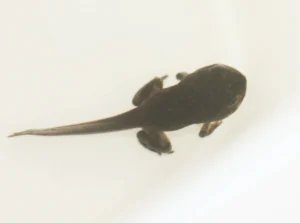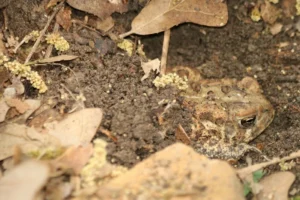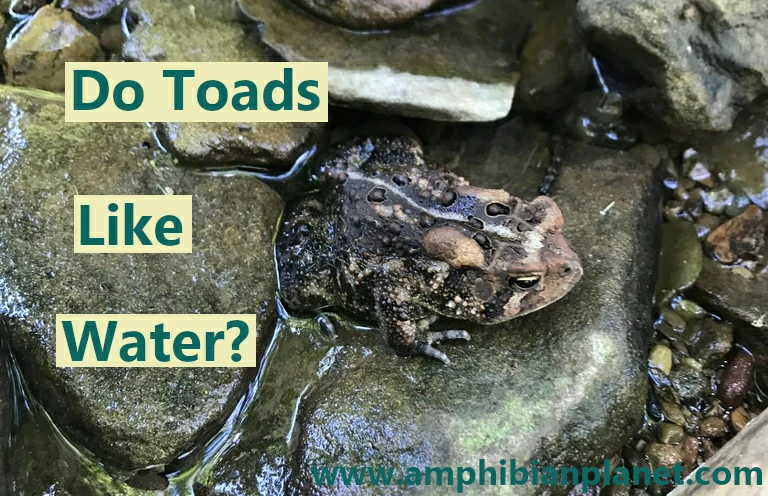Many people know that most frogs love to hang around water and are very efficient swimmers. Toads are a type of frog, so you may be wondering if they too like water.
Most toads require water to lay their eggs, and for their tadpoles to develop. However, once the tadpoles complete metamorphosis and transform into toads, they generally live a highly terrestrial life, only returning to the water during the mating season.
A few toad species do not have tadpoles and breed entirely on land. They either lay eggs which then hatch into miniature toads, or keep the eggs inside their bodies and give birth directly.
These toads can survive and successfully reproduce without the limitation of a direct dependency on water.
Most Frogs Start Their Lives In Water
The majority of toad species lay their eggs in shallow, standing, or slow-moving freshwater bodies that are free of predatory fish.
This could be in woodland ponds, seasonal pools, temporary rain puddles, flooded ditches, lake edges, river backwaters, bogs, marshes, swamps, and even in deep tire tracks or potholes filled with rainwater.
The eggs are usually laid in long strings (one to three eggs wide) along plants or resting on the pond bottom.
After a few days, to a few weeks, tiny tadpoles hatch from these eggs. Tadpoles are very different from adult toads; this is because they’re adapted for a fully aquatic life (life in the water), while adult toads are adapted for a mostly terrestrial life (life on land).

The tadpoles have gills, and live entirely in the water, just like fish.
Over time, the tadpoles will go through a process known as metamorphosis in which they will transform into juvenile toads with features for a terrestrial life.
During metamorphosis, the thyroid gland secretes a growth hormone called thyroxine.
This hormone triggers the tadpoles to:
- Lose the gills, and develop lungs for breathing air
- Absorb the tail into the body
- Grow strong legs for moving on land
- Remodel other organs to form an adult frog

Once this process is complete, tiny toadlets (young toads), typically half an inch long will leave the water and live a fully terrestrial life. These toadlets will grow into adult toads over time, and once they mature, they will return to the water to breed.
Adult Toads Do Not Spend Much Of Their Time In Water
Adult toads spend most of their lives on land and rarely go into the water. Their features are mostly adapted for life on land rather than in the water, and they are not as strong of swimmers as aquatic frogs.
Toads typically have short hind legs (for walking or hopping short distances) and non-webbed feet (they typically have digits or spaded feet).
This is in contrast to most true frogs which have long powerful hind legs (for hopping long distances & propelling themselves in water) and fully webbed feet.
This difference means toads can not swim as strongly or as efficiently as most true frogs can.
Since they spend the majority of their time on dry land, their hind legs are more adapted for digging burrows in soft soil or mulch where the toad can hide and protect itself from the elements.

Many toads have special, hardened knobs on their hind feet that help them dig into the soil. They use their back legs to ‘knead’ their bodies into the soil, burying themselves completely.
How deep they dig can vary from time to time. Some toads can burrow anywhere from 6 inches to over 3 feet deep.
All Toads Require Water To Survive
Although toads generally spend most of their time on land, like all animals, they need to consume water to survive.
Dehydration can be harmful, and even potentially lethal to most frogs. Their need for water is as critical as their need for food or oxygen–it’s an essential substance, that keeps their bodies working normally.
Toads bodies need a steady supply of fluids to transport nutrients, eliminate waste, and perform many other important functions.
That said, it’s important to note that toads and frogs do not drink water through their mouths like we do. Instead, they rehydrate by absorbing water across their permeable skin, in a process known as ‘cutaneous absorption’.
Amphibians have unique skin compared to that of many other vertebrates. Their skin is composed of thin membranous tissue that is quite permeable to water and contains a large network of blood vessels.
This permeable skin distinguishes them from mammals, birds, or reptiles.
Permeability relates to how easily a gas or liquid molecule can pass back and forth from the environment into the animal and vice versa.
Typically, the larger the molecule, the more difficult it is to enter the animal through its skin. Amphibian skin is more permeable than that of other vertebrates.
Their membranous skin allows water and respiratory gases to readily diffuse directly down their gradients between the blood vessels and the surroundings.
Many toads are even known to rehydrate by absorbing moisture from moist soil, through their skin
Some Toads Can Survive for Several Months Without Direct Access to Water
Some toads live in very arid habitats and have developed adaptations to help them cope with their environment.
Some toads burrow underground during the dry season, to avoid heat and desiccation. They can stay underground for several months while they wait for the next rains to fall.
Some toads such as the green toad (Bufotes viridis) are very tolerant to arid conditions.

Green toads can tolerate extremely high temperatures of 40°C (104°F). They are also quite tolerant to desiccation and can withstand losing up to 50% of their body water (they only die when they lose more than 50% of their body water).
Common Questions About Toads And Water
Do toads like water?
Toads generally live a highly terrestrial life and are not as dependent on water as most other frogs are. However, most toads still require bodies of standing fresh water to lay their eggs in.
Toads typically have short hind legs and non-webbed feet adapted for digging burrows in soft soil or mulch. Due to this, toads are generally not as strong of swimmers as aquatic frogs are.
Do toads live in water?
Most frogs start their lives as tiny tadpoles that live entirely in the water. Over time these tadpoles will go through a process known as metamorphosis and transform into miniature toads that live on land.
Once the transformation from tadpole to toad is complete, toads do not live in water – but instead live a mostly terrestrial life.
Do toads live near water?
Toads generally live further away from water than most true frogs. However, during the mating season, toads are often found near bodies of freshwater where they mate and lay their eggs.
Conclusion
Toads are amphibians, which means they live part of their lives in water and part on land. Most toads (not all) start their lives as fully aquatic tadpoles with gills, just like fish.
Over time, the tadpoles develop and transform into miniature toads that live entirely on land. These young toads will grow into adults and will return to the water to mate and lay their eggs.
Sources:
J. Bentley, T. Yorio; Do Frogs Drink? J Exp Biol1 April 1979; 79 (1): 41–46. doi: https://doi.org/10.1242/jeb.79.1.41


